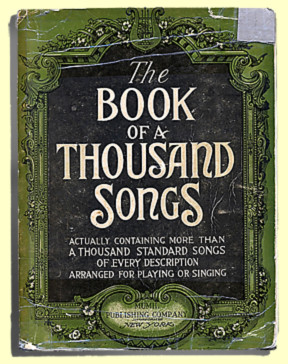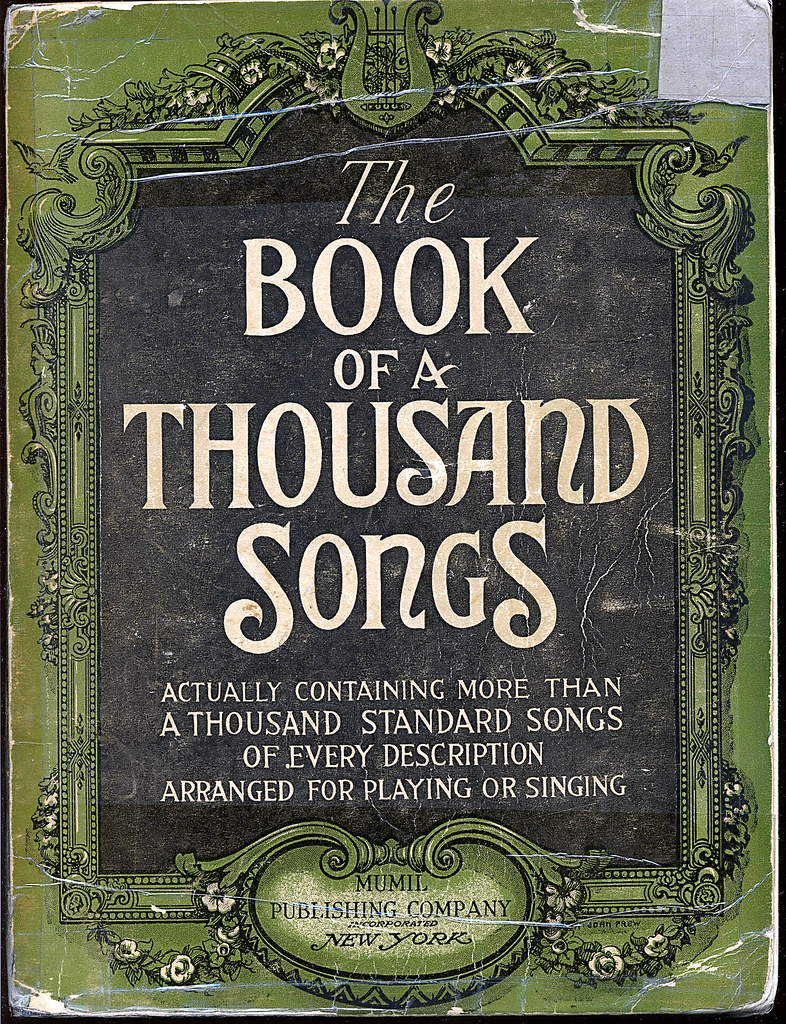.

In which I continue my traversal of The Book of a Thousand Songs [Wier, 1918]
p 19: "Angel Gabriel" [J.E. Stewart], "A, B, C, Tumble Down D" [no credits].
The latter is a puddin' and the former is a fake. "Angel G" is a 'gwine' song with a credited writer, so it would seem to have been intended for a minstrel show or perhaps a book of sentimental songs of the south. Dotted rhythms, but very little syncopation.
"ABC" is in 6/8, which isn't the way I heard it on a kiddie LP we had in the house when I was a kiddie. I recall thinking it was the stupidest thing I'd ever heard, but I guess I hadn't heard a lot of things at that time, because it's been topped repeatedly since then. Is this the first song in the book that has no writer credited at all? It's far from the last. A perfunctory Google offers no hints.
p 20: "Afterwards" [Mary Mark Lemon, J.W. Mullen].
Unless otherwise noted, the lyricist's name precedes the composer's.
A sentimental song with nothing that strikes me as remarkable in the lyrics. The arrangement, which I expect reflects the composer's work, though it adheres to the general rule of the book in having no chord thicker than three notes in either hand, varies the figures used and seems to be competent and craftsmanlike, if not stunning.
p. 21: "Ave Maria" [Bach-Gounod], "Ah, 'Tis a Dream" [E. Lassen].
Bach's most famous prelude, the first from Book 1 of "The Well-Tempered Clavier," was used by Charles Gounod (best known for his opera "Faust" and for "Funeral March of a Marionette," which was used as the theme for Alfred Hitchcock's TV show) as an accompaniment to the melody of an Ave Maria. The view that this was a wonderful achievement is undercut by George Bernard Shaw's claim that all Gounod did was pull out the underlying harmony Bach put in. Still, it's popular to this day in all sorts of arrangements. This one leaves out the Bach prelude completely and gives a choral setting (SATB) of the Gounod part. You could play this and have a friend play the Bach on another keyboard, but you'll have to transpose the prelude up to G to match the key, and be sure and use the version of the prelude with the extra measure Schwenke inserted, which is most of the versions you'd have found before modern scholarship started asserting itself on the matter.
Lassen's song is a nostalgic wish for home, written in 9/8 with some duplets for emphasis. Wier let this one go on for three verses. Maybe he liked it.
p. 22: "Araby's Daughter" [Thomas Moore, E. Kiallmark], "Annie Laurie" [Lady John Scott].
Here's Moore again, going for the exotic this time. He had a lot of songs on the hit parade, and a number of them still ring a bell today. Kiallmark doesn't ring a bell, and unlike Haydn, we don't see his name and wonder which of his many works was used in the creation of this song. The 6/8 rhythm is dotted and snappy, but not unrelievedly so.
"Annie Laurie" was a real person, erstwhile sweetie of William Douglas, who wrote the poem Alicia Scott modified and added a tune to, modified from one she had written for another Scottish setting. Douglas's own authorship is sometimes questioned because of the original poem's similarity (altered by Scott in her setting) to "Jon Anderson, My Jo." However, the first and third verses aren't questioned, and he really did go out with Annie Laurie before marrying someone else.
p. 23: "Angels Meet Me at de Cross-roads" [W.S. Hays], "Alma Mater, O"
I looked up Hays to see if it was the Will Hays who wrote some other songs. His full name was William Shakespeare Hays, and titles I seem to remember include "Who Cares?" "Keep in de Middle ob de Road" and "Sweet Violets." Not that one, I'm sure. I found a book of his Poems and Songs at Google Books (scanned from an autographed copy), and it has this touchingly humble note at the front of the book:
"To My Friends: If I have done wrong in publishing this book, forgive me."The song itself is nothing much special. He also wrote "Irish" songs.
"Alma Mater, O" is a run-of-the-mill toast to the college one is about to leave, and the tune seems to be nothing more than the first strain of "The Wearin' of the Green" sung twice. Four times, if you sing both verses.
p. 24: "Angelina Baker" [Stephen C. Foster], "A-Roving"
Angelina's another sweet dead chick that the blackfaced narrator misses. For a sad song, it's rather sprightly in a 2/4 Allegretto, and ends with an incongruously catchy rhythm on the line "She left me here to weep a tear, and beat on de old jaw-bone."
"A-Roving" shows the folk process at work, circa 1918. The version of this that I always hear has more snappy rhythms than the comparatively square setting here. Needless to say, this version is also cleaner than I generally hear, too.
p. 25: "Among the Lilies" [H.B. Farnie, Alphons Czibulka], "All Through The Night" [Old Welsh Song]
I suspect Farnie simply showed up uninvited one day and imposed his lyrics on this to make a song, as the melody is Czibulka's gavotte "Stephanie." The composer was a bandmaster who wrote a lot of Viennese trifles. "Love's Dream After the Ball" turns up in old collections, as does "Stephanie." He may be best known for "Hearts and Flowers," a song for which Tobani took full credit, but which seems to be lifted wholesale from "An Old Winter's Tale." The theme can be heard during many pathetic moments in silent movies and old cartoons.
"All Through the Night" is a lullaby everybody should know. My favorite arrangement to play is not this one, but rather the one in Gems of the Universe, a smaller collection that's jam-packed with great songs (I played all the way through it over a few days when I lived in Virginia, so this project is not entirely unprecedented).
Also posted to my Live Journal.
.
